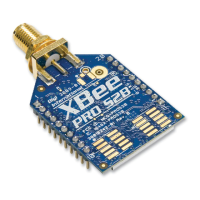XBee ZigBee networks Channel scanning for the XBee/XBee-PRO ZB RF Module
XBee/XBee-PRO ZigBee RF Modules User Guide 51
Example: joining a network
After starting a coordinator (that is allowing joins), the following steps will cause an XBee end device to join the
network:
1 Set ID to the desired 64-bit PAN ID, or to 0 to join any PAN.
2 Set SC to the list of channels to scan to find a valid network.
3 If SC or ID is changed from the default, apply changes (make SC and ID changes take effect) by issuing the AC
or CN command.
4 The Associate LED will start blinking once the end device has joined a PAN.
5 If the Associate LED is not blinking, the AI command can be read to determine the cause of join failure.
6 Once the end device has joined, the OP and CH commands will indicate the operating 64-bit PAN ID and
channel the end device joined.
7 The MY command will reflect the 16-bit address the router received when it joined.
8 The API Modem Status frame (“Associated”) is sent out the UART (API firmware only).
9 The joined end device will attempt to enter low power sleep modes based on its sleep configuration
commands (SM, SP, SN, ST, SO).
Channel scanning for the XBee/XBee-PRO ZB RF Module
As mentioned previously, routers and end devices must scan one or more channels to discover a valid network to
join. When a join attempt begins, the XBee sends a beacon request transmission on the lowest channel specified
in the SC (scan channels) command bitmask. If a valid PAN is found on the channel, the XBee will attempt to join
the PAN on that channel. Otherwise, if a valid PAN is not found on the channel, it will attempt scanning on the
next higher channel in the SC command bitmask. The XBee will continue to scan each channel (from lowest to
highest) in the SC bitmask until a valid PAN is found or all channels have been scanned. Once all channels have
been scanned, the next join attempt will start scanning on the lowest channel specified in the SC command
bitmask.
For example, if the SC command is set to 0x400F, the XBee would start scanning on channel 11 (0x0B) and scan
until a valid beacon is found, or until channels 11, 12, 13, 14, and 25 have been scanned (in that order).
Once an XBee router or end device joins a network on a given channel, if the XBee is told to leave (see Leaving a
network on page 50), it will leave the channel it joined on and continue scanning on the next higher channel in
the SC bitmask.
For example, if the SC command is set to 0x400F, and the XBee joins a PAN on channel 12 (0x0C), if the XBee
leaves the channel, it will start scanning on channel 13, followed by channels 14 and 25 if a valid network is not
found. Once all channels have been scanned, the next join attempt will start scanning on the lowest channel
specified in the SC command bitmask.
Managing multiple ZigBee networks
In some applications, multiple ZigBee networks may exist in proximity of each other. The application may need
provisions to ensure the XBee joins the desired network. There are a number of features in ZigBee to manage
joining among multiple networks. These include the following:
PAN ID filtering
Preconfigured security keys
Permit joining

